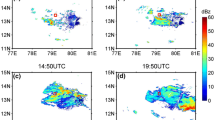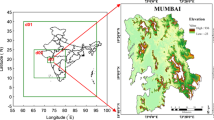Abstract
A new Planetary Boundary Layer (PBL) model (namely MY-4 in this paper) was developed with reference to Mellor-Yamada’s Level 4 turbulent closure concept. Having been coupled with a meso-scale model MM5, MY-4 was utilized to simulate a heavy-rain process, which took place over South China during June 8–9, 1998. Its model outputs indicated that the rainfall process was well captured in terms of its intensity and geographical distribution. More importantly, in comparison with MM5’s original boundary layer models, MY-4 made the following improvements: (1) MY-4 not only simulated the major weather systems like low vortexes and low-level jets more accurately, thus improving the general weather pattern of the rainfall process, but it was also capable of restraining the occurrence of false rainfall centers with maximum precipitation amounts exceeding 160 mm. (2) Having been compared with the wind profile observed at Hong Kong, it revealed that MY-4 could reproduce the wind speed fluctuations in a short time scale reasonably well, which was not yet achieved in the original PBL models in MM5. Furthermore, a more detailed comparative study was made on the results simulated by MY-4 and a PBL model (which is based on Mellor-Yamada’s Level 2.5 concept) respectively. It showed that the contributions of turbulences generated by the two categories of PBL models to the wind fields at a lower atmosphere were increasingly different even in the first 1–2 hours of integrations. As the analysis demonstrated, under the nonlinear interactions within the meso-scale MM5 model, it was the turbulences in the boundary layer that had the most important impacts on the final model outputs and MY-4 seemed to better reflect this turbulent process, hence leading to the aforementioned improvements.
Similar content being viewed by others
References
Tao, S. Y., Heavy Rainfall in China (in Chinese), Beijing: Science Press, 1980, 120–121.
Ding, Y. H., Study on the Continues Heavy Rainfall over Jianghuai Basin in China in 1991 (in Chinese), Beijing: Meteorological Press, 1993, 55–56.
Tao, S. Y., Ni, Y. Q., Zhao, S. X., Study on the Mechanism and Forecast of the Heavy Rainfall over China in Summer of 1998 (in Chinese), Beijing: Meteorological Press, 2001, 168–169.
Blackadar, A. K., The Vertical distribution of wind and turbulent exchange in a neutral atmosphere, J. Geophys. Res., 1962, 67: 3095 -3102.
Bougeault, Ph., Lacarrere, P., Parameterization of orography induced turbulence in a meso-scale model, Mon. Wea. Rev., 1989, 117: 1872–1890.
Jiang, W. M., Zhou, M., Xu, M. et al., Study on development and application of a regional PBL numerical model, Boundary-layer Meteorology, 2002, 104: 491–503.
Mellor, G. L., Yamada, T., Ahierarchy of turbulence closure models for planetary boundary layers, J. Atmos. Sci., 1974, 31: 1791–1806.
Mellor, G. L., Yamada, T., Development of a turbulence closure model for geophysical fluid problems, Rev. Geophysics and Space Physics, 1982, 20: 851–875.
Andre, J. C., Moor, G D., Lacarrere, P. et al., Modeling the 24-hour evolution of the mean and turbulent structures of the planetary boundary layer, J. Atmos. Sci., 1978, 35: 1861–1883.
Li, X. S., Numerical simulation of the neutral PBL in night by a high closure model, Atmosphere Science (in Chinese), 1986, 10: 154–163.
Moeng, Chin-Hoh., A large-eddy-simulation model for the study of planetary boundary-layer turbulence, J. Atmos. Sci., 1984, 41: 2052 -2062.
Janjic, Z. L., The step-mountain Eta coordinate model: further developments of the convection, viscous sublayer, and turbulence closure schemes, Mon. Wea. Rev., 1994, 122: 927–945.
Janjic, Z. I., The Mellor-Yamada level 2.5 scheme in the NCEP Eta model, Eleventh Conference on Numerical Weather Prediction, Norfolk, VA, 19–23 August 1996, Boston: American Meteorological Society, 333–334.
Gerrity, J. P., Black, T., The numerical solution of the Mellor-Yamada Level 2.5 turbulent kinetic energy equation in the Eta model, Mon. Wea. Rev., 1994, 122: 1640–1646.
Burk, S. D., Thompson, W. T., A vertically nested regional numerical weather prediction model with second-order closure physics, Mon. Wea. Rev., 1989, 117: 2305–2324.
Moeng, C. H., Wyngaard, J. C., An analysis of closures for pressure-scalar covariance in the convective boundary layer, J. Atmos. Sci., 1986, 43(21): 2499–2513.
Moeng, C. H., Wyngaard, J. C., Evaluation of turbulent transport and dissipation closures in second-order modeling, J. Atmos. Sci., 1989, 46(14): 2311–2330.
Cheng, Y., Canuto, V. M., Howard, A. M., An improved model for the turbulent pbl, J. Atmospheric Sci., 2001, 59: 1550–1565.
Castelli, S. T., Ferrero, E., Anfossi, D., Turbulence closures in neutral boundary layers over complex terrain, Boundary-layer Meteorology, 2001, 100: 405–419.
Nakanishi, M., Improvement of the Mellor-Yamada turbulence closure model based on large-eddy simulation data, Boundary-layer Meteorology, 2001, 99: 349–378.
Rotta, J. C., Statistische Theories nichthomogener Turbulence, 1. Z. Phys., 1951a, 129: 547–572.
Rotta, J. C., Statistische Theories nichthomogener Turbulence, 2. Z. Phys., 1951b, 131: 51–77.
Kolmogorov, A. N., The local structure of turbulence in incompressible viscous fluid for very large Reynoldsnumber, Dokl. Acad. Nauk SSSR, 1941, 30:301.
Zhou, X. J., Xue, J. S., Tao, Z. Y. et al., Study on the 98 HUAMEX (Torrential rainfall experiment over the both side of the Taiwan Strait and adjacent area) (in Chinese), Beijing: Meteorological Press, 2003, 156–218.
Zhao, P., Sun, J., Zhou, X. J., Mechanism of formation of low level jets in the south China Sea during spring and summer of 1998, Chinese Science Bulletin, 2003, 48(12): 1265–1270.
Liu, S. Y., Tao, Z. Y., Analysis of the relation between low level jet and the heavy rain by wind profiler data, J. Tropical Meteo (in Chinese), 2003, 19: 285–290.
Sun, J., Liu, S. Y., An Analysis for the Meso-scale convective systems in a heavy rain process during June 8th to 10th 1998 at Hong Kong, Atmos. Science (in Chinese), 2004, 28: 713–721.
Sun, J., Zhao, P., Zhou, X. J., The meso-scale structure of a South China rainstorm and the influence of the complex topography, Acta Meteor. Sinica (in Chinese), 2002, 60(3): 333–342.
Maddox, R., A Meso-scale convective complexes, Bull. Amer. Meteor. Soc., 1980, 61: 1374–1387.
Hong, S. Y., Pan, H. L., Nonlocal boundary layer vertical diffusion in a medium-range forecast model, Mon. Wea. Rev., 1996, 124: 2322–2339.
Betts, A. K., Anew convective adjustment scheme, Part I: Observational and theoretical basis, Quart. J. Roy. Meteor. Soc., 1986a, 112: 677–692.
Betts, A. K., Miller, M. J., A new convective adjustment scheme, Part II: Single column tests using GATE wave, BOMEX, ATEX and Arctic Air-mass data sets, Quart. J. Roy. Meteor. Soc., 1986b, 112: 677–692.
Author information
Authors and Affiliations
Corresponding author
About this article
Cite this article
Sun, J., Zhou, X. & Zhao, P. A new Planetary Boundary Layer model and its application to heavy rain modeling. Chin.Sci.Bull. 50, 1756–1766 (2005). https://doi.org/10.1360/03wd0600
Received:
Accepted:
Issue Date:
DOI: https://doi.org/10.1360/03wd0600




